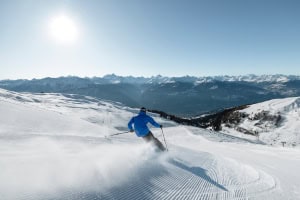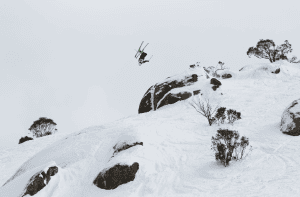Gear Guide – The Importance of a Good Ski Boot-Fit

Everything the light touches is yours – a boot fitter’s wet dream. Image:: Chani Caulfield
In partnership with FootPro
Mountainwatch | Chris Booth
Everyone has horror stories about ski boots. I’ve even heard stories of people quitting skiing over them. They are the ultimate necessary evil of skiing – well that and lift tickets. I have probably made every mistake in the book when it comes ski boots, and I’ve got the feet to show for it. But I think I’ve at least got the basics down by now, and if I’ve learnt one thing it’s that there’s no such thing as skiing in ugg boots. Or, if you want to ski in ugg boots, try snowboarding.
The key is to get boots that fit properly and that make your skiing as effortless as possible. That means maximising transmission of power from your legs, through your boots and into your skis. You don’t want to be trying to ‘maneouvre’ your boots so that you can turn your skis. You just don’t.
To get maximum power transmission you generally want the smallest, most precise boot possible. But let’s face it, those ain’t gonna be comfortable.
So how do you get maximum power transmission with maximum comfort? I follow three rules:
- See a boot fitter. Seriously, if you want to ski hard all day in your boots you need to consult a boot geek. They will point out things about your feet, knees and stance that will open your eyes about the way you ski. They will also talk you down from buying those ridiculously stiff and uncomfortable race boots with a 140 flex that you think you need.
- Put a custom footbed in it. There are lots of different insoles on the market, some heat-mouldable, some conformable that just mould as you ski. The choice is yours, just avoid those pancake looking thingies that come with your boots.
- Put a custom liner in it. I go with Intuition Power Wrap liners. Intuition liners are foam-injected, heat-mouldable inner boots that work with any shell. This tongueless liner is just about the stiffest on the market, and wraps around the ankle locking the heel down in a way that’s hard to beat. The wrap also removes the pain you often get down the shin with traditional tongue liners because there are no pressure points.
But that’s just the basics. To drill down a little deeper I called Simon Ashton from Footpro in Melbourne – a serious boot geek – to find out what to actually do when you go and get your boots fitted.
After a little bit of a pow wow about how good Mt Buller is, Simon nailed it down to 5 key tips.
- Listen to your boot fitter, but also listen to yourself. “I see a foot and have my own ideas of what will match it. But at the end of the day the customer is going to feel different things that I can’t identify just by looking at them,” says Simon, “a good boot fitter will always have a discussion with you to get you into the right boot, and we rely as much on the customer’s feedback as our own expertise to find the sweet spot.”
- Be honest. “Almost everyone who comes in to Footpro says they are an ‘advanced intermediate’, but what does that mean exactly? Be upfront and tell us everything, it’s kind of like visiting a doctor, the more information you give us the better we can diagnose any foot issues you may have, and then we can use that information to help you into a boot that isn’t just comfortable, but actually solves some of the problems you have been experiencing when you ski.”
- Bring your old boots with you. “Then we can see what’s not working. When a customer brings in their old boots and stands in them for us, we can see what’s wrong a whole lot more clearly.”
- Don’t self-diagnose. “It’s so easy now just to google your problems, but it’s almost always wrong. Fitting a foot into a boot is not always straight forward, because boot pain is often caused by a combination of things, including stance, pronation, and even skiing ability and technique – not just foot composition. For example, is your wide-looking foot caused by an over-pronating collapsing (flat) foot or is your foot actually wide? It’s important that someone with experience actually analyses what’s going on, otherwise you can end up doing more harm than good.”
- Have an open mind. “It’s easy to set your mind on a certain model or colour. But there are so many options on the market now, and often the boot that you came in thinking you would buy isn’t actually the boot that fits you best.”

The ol’ pressure plate: this thing assesses your boot alignment, stance efficiency and balance. Image:: Chani Caulfield






